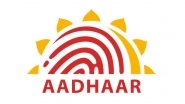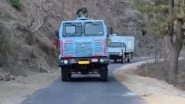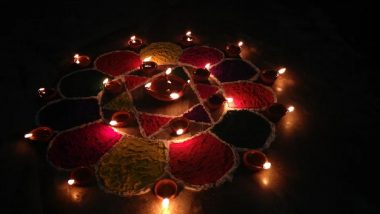New Delhi, October 17: As COVID-19 has hit this year's Navratri celebrations, people have found different ways to observe over a week-long fasting and Kanya Poojan keeping all health protocols in mind to contain the spread of the deadly virus.
In pre-COVID times, the 10-day-long celebrations included dancing, music programmes, dramas, fairs, folk songs, among other events. People used to perform puja with the community at the temple and events at home. But this year, because of social distancing and protecting oneself and family, there is variation in the usual celebration of Navratri. Also Read | Bigg Boss 14: Contestant Pavitra Punia’s Ex Pratik Sehajpal To Enter the Show as A Confirmed Contestant?.
1. Performing South Indian Navratri Tradition of ‘Bommai Golu’ Online
This year because of the ongoing pandemic, the south Indian tradition of displaying 'bommai golu' dolls, bommai hopping, and having visitors at home has changed. To keep the tradition alive, people are now switching to online platforms to display the new addition to their golu doll collection. Also Read | Chhalaang Trailer: Rajkummar Rao, Nushrratt Bharuccha, Mohammed Zeeshan Ayyub’s Social Comedy From Heartlands of India Looks Endearing (Watch Video).
2. Making Fasting-Food at Home
Some people are not even bringing packaged food items or sweets like chaulai laddoo or salted potato chips, which is consumed by people while fasting. They are instead making it at home. Muskan, 21, an employee at Tech Mahindra, said, "We are making the chaulai laddoo or potato chips that we consume during fast at home only, instead of brining it from the markets because of the fear of the virus."
3. Perfoming ‘Keertan’ Alone
Festivals are a way of bringing people together and not just about rituals. Hosting 'keertans' at home or singing bhajans together with lots of people is normally how people have been celebrating the festivals. But now to maintain distancing and avoid any social contact, people this year are planning to perform bhajans and 'keertans' alone at home just with the family without any invitees.
4. Feeding Stray Cows for Kanya Poojan
Kanya Pujan is celebrated on the eighth and ninth day of Navratri in Northern India. Little girls are invited to the home of people who are organising the pujan and are revered like goddesses. However, this year to ensure the safety and health of girls, people might not be comfortable in sending them to other homes. A great alternative to this year's celebration is to feed stray cows.
5. Packing Food for Kanya Poojan
Another alternative to performing kanya poojan is by packing the food into properly sanitised packets and sending it to their homes.
6. Feeding the Poor
As 'Bhandaras' are not happening, feeding the poor during such times is an act of kindness and caring for the distressed. The food from Kanya Pujan can also be distributed to fill the bellies of the poor girls on the streets. Muskan said, "Instead of calling girls home, our family is planning to distribute the 'prasad' to the poor girls from streets and it is an act of 'punya'."
7. Girls Dressing Up at Home
Little girls dress up like goddesses to attend kanya pujan but this year it can be done by dressing them up and having Zoom calls with relatives and celebrating it over virtual platforms. Homemaker Nandini Saha said, "I will dress up my daughter as she is excited to wear lehenga choli just like every year but I am not thinking of sending her to other houses for the pujan because of the safety reason as children already have low immunity and she is 7-years-old. I am also planning to have a Zoom call with relatives and friends to celebrate the festival".
8. Making Small Pandals at Home
Another thing that you can do is create a small pandal at your home for the puja using decorative ideas from the internet. Talking about Pandal, Muskan said, "Every year, I go to CR Park for Durga Puja with my family but this year we are not sure because of the pandemic and safety of the family. We are creating our own pandal at home with background and theme-based decoration."
9. Performing Garbha or Dandiya-Raas at Home
In western India, Navratri is known for Garbha or the Dandiya-Raas dance in which men wearing turbans and kedias and women wearing chaniya- cholis participate in pairs with small, decorated bamboo sticks, called dandiyas in their hands. However, this year it would be difficult to perform the dance in circles and with lots of people. People are trying to find happiness amidst the pandemic by organising these dance performances at home with their closed circles.
The word Navratri translates to 'nine nights'. In most of the parts of India different forms of the goddess, Maa Durga, are worshipped during these nine nights-- Shilaputri, Brahmacharni, Chandraghanta, Kushmanda, Skandama, Katyayani, Kalratri, Maha Gauri, and Siddhidatri.
The first day starts with the night of Amavasya, or a new moon which marks the beginning of the Navratri puja. The celebration of Navratri concludes with Vijayadasami, popularly known as Dussehra.
(The above story is verified and authored by ANI staff, ANI is South Asia's leading multimedia news agency with over 100 bureaus in India, South Asia and across the globe. ANI brings the latest news on Politics and Current Affairs in India & around the World, Sports, Health, Fitness, Entertainment, & News. The views appearing in the above post do not reflect the opinions of LatestLY)













 Quickly
Quickly


